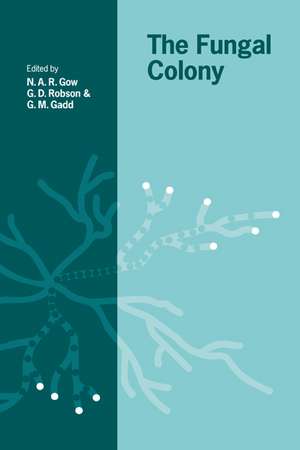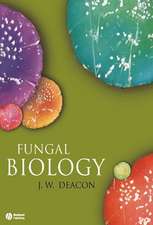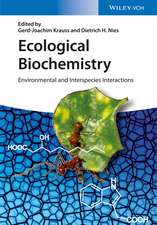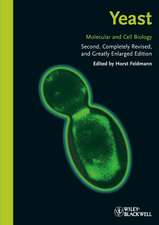The Fungal Colony: British Mycological Society Symposia, cartea 21
Editat de N. A. R. Gow, G. D. Robson, G. M. Gadden Limba Engleză Paperback – 31 dec 2007
| Toate formatele și edițiile | Preț | Express |
|---|---|---|
| Paperback (1) | 427.94 lei 6-8 săpt. | |
| Cambridge University Press – 31 dec 2007 | 427.94 lei 6-8 săpt. | |
| Hardback (1) | 783.67 lei 6-8 săpt. | |
| Cambridge University Press – 14 apr 1999 | 783.67 lei 6-8 săpt. |
Din seria British Mycological Society Symposia
- 11%
 Preț: 440.78 lei
Preț: 440.78 lei -
 Preț: 382.99 lei
Preț: 382.99 lei -
 Preț: 404.68 lei
Preț: 404.68 lei -
 Preț: 434.12 lei
Preț: 434.12 lei -
 Preț: 320.55 lei
Preț: 320.55 lei - 14%
 Preț: 782.83 lei
Preț: 782.83 lei - 11%
 Preț: 532.53 lei
Preț: 532.53 lei - 11%
 Preț: 435.33 lei
Preț: 435.33 lei - 14%
 Preț: 767.64 lei
Preț: 767.64 lei -
 Preț: 357.89 lei
Preț: 357.89 lei -
 Preț: 416.98 lei
Preț: 416.98 lei -
 Preț: 323.56 lei
Preț: 323.56 lei - 11%
 Preț: 472.83 lei
Preț: 472.83 lei - 11%
 Preț: 478.08 lei
Preț: 478.08 lei - 11%
 Preț: 676.05 lei
Preț: 676.05 lei -
 Preț: 398.54 lei
Preț: 398.54 lei -
 Preț: 354.25 lei
Preț: 354.25 lei -
 Preț: 268.13 lei
Preț: 268.13 lei - 11%
 Preț: 438.40 lei
Preț: 438.40 lei
Preț: 427.94 lei
Nou
Puncte Express: 642
Preț estimativ în valută:
81.88€ • 85.95$ • 67.97£
81.88€ • 85.95$ • 67.97£
Carte tipărită la comandă
Livrare economică 10-24 aprilie
Preluare comenzi: 021 569.72.76
Specificații
ISBN-13: 9780521048064
ISBN-10: 0521048060
Pagini: 344
Ilustrații: 66 b/w illus. 16 tables
Dimensiuni: 150 x 228 x 20 mm
Greutate: 0.5 kg
Editura: Cambridge University Press
Colecția Cambridge University Press
Seria British Mycological Society Symposia
Locul publicării:Cambridge, United Kingdom
ISBN-10: 0521048060
Pagini: 344
Ilustrații: 66 b/w illus. 16 tables
Dimensiuni: 150 x 228 x 20 mm
Greutate: 0.5 kg
Editura: Cambridge University Press
Colecția Cambridge University Press
Seria British Mycological Society Symposia
Locul publicării:Cambridge, United Kingdom
Cuprins
List of contributors; Preface; 1. Self-integration - an emerging concept from the fungal mycelium A. D. M. Rayner, Z. R. Watkins and J. R. Beeching; 2. Nutrient translocation and electrical signalling in mycelia S. Olsson; 3. Colony development in nutritionally heterogeneous environments K. Ritz and J. W. Crawford; 4. Circadian rhythms in filamentous fungi M. Ramsdale; 5. Growth, branching and enzyme production by filamentous fungi in submerged culture A. P. J. Trinci, S. Bocking, R. J. Swift, J. M. Withers, G. D. Robson and M. G. Wiebe; 6. Metabolism and hyphal differentiation in large basidiomycete colonies S. Watkinson; 7. Role of phosphoinositides and inositol phosphates in the regulation of mycelial branching G. D. Robson; 8. Stress responses of fungal colonies towards toxic metals L. M. Ramsay, J. A. Sayer and G. M. Gadd; 9. Cellularization in Aspergillus nidulans J. E. Hamer, J. A. Morrell, L. Hamer, T. Wolkow and M. Momany; 10. Genetic control of polarized growth and branching in filamentous fungi G. Turner and S. D. Harris; 11. Mating and sexual interactions in fungal mycelia G. W. Gooday; 12. Genetic stability in fungal mycelia M. L. Smith; 13. Nuclear distribution and gene expression in the secondary mycelium of Schizophyllum commune J. G. H. Wessels, T. A. Schuurs, H. J. P. Dalstra and J. M. J. Scheer; Index.
Descriere
An authoritative information on the properties of the fungal colony.








